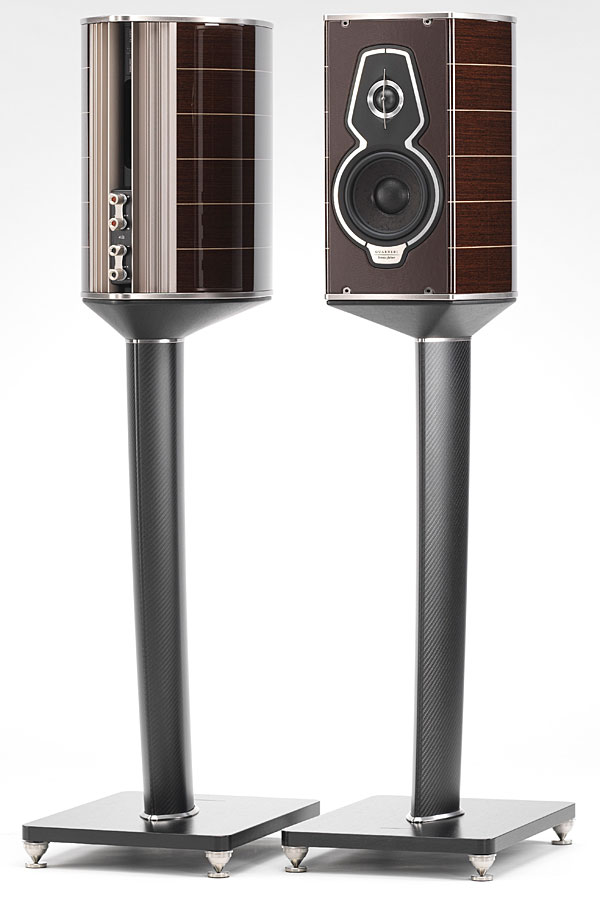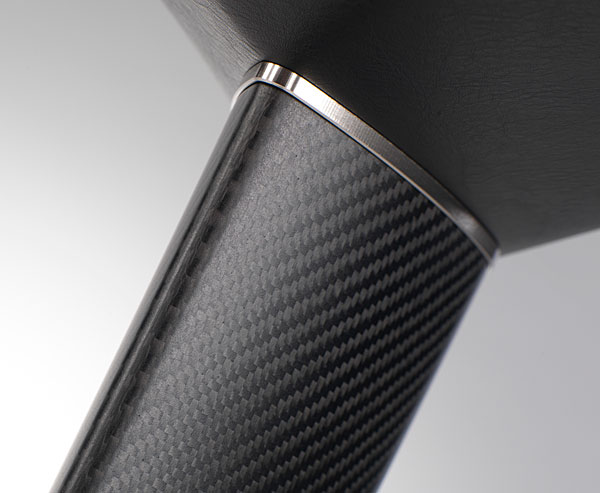| Columns Retired Columns & Blogs |
... KEF Reference 5 seems well worth it.
https://www.stereophile.com/content/kef-reference-5-loudspeaker
Or, you could go with the Reference 1 at half the price.
The Guarneris' enclosures seemed inert when I rapped their panels with my knuckles; but listening to the sidewalls with a stethoscope as I played pink noise, I could hear some emphasis between 300 and 400Hz. This behavior seemed to have no audible effects with music, however, male voices acquiring no additional thickness. The Sonus Fabers differentiated Leonard Cohen's low-pitched voice in "First We Take Manhattan," from his I'm Your Man (16/44.1 stream, Columbia/Tidal), from the synth-heavy backing. Peculiarly, the 320kbps, lossily-compressed AAC version of this song I found in my library—no idea how it got there—sounded a bit less congested in the treble than the uncompressed Tidal stream.

The 1/3-octave warble tones on Editor's Choice extended cleanly and evenly through the 40Hz band, with the 32Hz tone boosted by the lowest-frequency mode in my room. The 25 and 20Hz tones weren't audible at my normal listening levels, but, commendably, no wind noise came from the ports when I listened from behind the speakers. The half-step–spaced tonebursts on Editor's Choice played evenly and with good control, and the low D-flat on my detuned Fender bass at the end of the 24-bit master file for "Deck the Halls," from Cantus's Comfort and Joy: Volume Two (CD, Cantus CTS-1205), had good weight without booming. Similarly, the double-bass line in Peter Gabriel's sympathetic take on David Bowie's "Heroes," from Gabriel's Scratch My Back (16/44.1 ALAC file from CD, Real World), was reproduced with enough low-frequency power to support the music, while the image of the singer was palpable.
Playing this superbly recorded album, an outlier in these days of the Loudness Wars, reminded me that, 30 years ago, rock recordings were made before dynamic range and light and shade had become dirty phrases among mastering engineers. Prefab Sprout's Steve McQueen (1985), retitled Two Wheels Good in the US (ALAC file ripped from CD, Columbia 4663362), was produced by Thomas Dolby; it amply illustrates the case against modern recording practices, and showed where the Sonus Fabers excelled.
In the Sprout's cover of Jim Reeves's hit "He'll Have to Go," the reverb on the girl singers in the haunting fade-in raised goose bumps—and when Paddy McAloon enters in the verse, the image of his voice hung between the speakers, naturally sized and stably positioned. In the album's final track—the "trucking mix" of the opener, "Faron"—every detail of the sound of the frantic banjo that enters in the chorus was crystal clear despite being mixed fairly low in level, but without that detail being unnaturally spotlit. Similarly, the properties of the various echo and reverb effects weren't obscured by higher-level elements of the mix. In "When Love Breaks Down," the woody character of the electric bass remained clearly portrayed throughout, as Dolby's mix changed from sparse and reverberant to full-bodied with a rhythmic groove.

Comparisons
The speakers that had preceded the Sonus Fabers in my room were GoldenEar Technology's floorstanding Triton References ($8498/pair), which I reviewed in the December 2017 issue. With their powered subwoofers, it should come as no surprise that the T Refs offered greater low-frequency extension than the Guarneris and a somewhat less-forward-sounding upper midrange. The stand-mounted Sonus Fabers, however, had a more delicate-sounding high treble and slightly greater precision of stereo imaging.
When I listened to the TAD Micro Evolution One ($14,290/pair with stands), I felt that its bass was on the light side. Compared directly with the TADs, the Sonus Fabers had a warmer balance in the lower midrange with "I Say," from Happy Rhodes's HR5 (16/44.1 ALAC, Aural Gratification), and with Robert Silverman's set of 23 piano sonatas by Beethoven (MQA FLAC files unfolded to 24/88.2, Silver Lining/Audio High). The TADs, however, had slightly less "jangle" audible in the die-aways of chords, though this wasn't apparent except in side-by-side comparisons.

The Guarneri Traditions offered soundstaging of similar superbness of stability and detail to that of the ME1s with my recent recordings of works by Latvian composer Eriks Ešenvalds, performed by Ethan Sperry and the Portland State Chamber Choir on their The Doors of Heaven (24/88.2 WAV files, Naxos 8.579008/HDtracks). If I had to swear to it, the ME1's upper-midrange balance was less forward, something that was noticeable in choral climaxes. Overall, however, I'd say that while sounding different from one another, the TAD and Sonus Faber were as equally matched in sound quality as they were in price.
Summing Up
Like its predecessors, Sonus Faber's Tradition edition of the Guarneri is expensive, and some of that price must be set against its styling and the standard of its construction. It's fair to note that the Bowers & Wilkins 805 D3, which I reviewed in March 2017, costs $7000/pair with matching stands and offers the Guarneri Tradition some competition in sound quality—though it's also fair to note that the Italian speaker is more neutrally balanced than the British, and offers greater low-frequency extension in-room. However, if you want sonic elegance matched with an equally elegant appearance, the Sonus Faber Guarneri Tradition is a contender. I very much enjoyed my time with it.

... KEF Reference 5 seems well worth it.
https://www.stereophile.com/content/kef-reference-5-loudspeaker
Or, you could go with the Reference 1 at half the price.

The KEF house sound is not as warm as SF's. At least from what I remember from an audition of LS50s. But much much pricier...

And I would venture to suggest they got the ideas for the metal/leather/two contrasting woods from the inside of a mid-range Mercedes :-)

This audio jewelry that measures like Q-Acoustics (in every area!) has moved beyond cliche years ago. This goes for the big names too >>---> MTM's with passive subs underneath with price tags that do nothing but serve to make the buyers look uninformed. And a publication that looks as if it speaks for science yet only speaks for those that think spending more equals getting something that is actually better.
The reality is, the majority of "high-end audio" has been made obsolete (performance wise) years ago. To substantiate what I am saying, take for example the speakers that Michael Fremer uses now. They are nothing more than MTM's (Midwoofer, Tweeter, Midwoofer) with large, passive subs underneath. Compare these measurement wise to a pair of Q-Acoustics 3050's at ~$1000 pair and high-pass them to a 2 pairs of SVS subs at $4k a pair total price ~$5000. Regarding bandwidth, frequency response, distortion and ultimate loudness the Q-Acoustics/SVS system will equal if not surpass the performance of the aforementioned system. As a result, I see no reason why blind listening involving a lay audience would only confirm it.
And if that fails, lets kick it up a notch. Replace the Q-Acoustics with a pair of Troels Gravesen designed, and actively high passed, SB acoustics Satori MTM's for the same total price (the drivers where designed by the same Engineering Team that designed the Scanspeak drivers that Wilson uses for Christ sakes).
Then play fare.
"To the simple, everything appears simple"
P.S. I'm aware of the many factors involved regarding sound quality and loudspeaker design and their SQ is not limited to distortion and frequency response. Indeed, diffraction, acoustic phase, spectral decay and box panel resonance constitute what are important roles in the end game and the above designs listed perform as good any in these areas.

There are great monitors around for half that can compete with these beauties, The Focal Diablo comes to mind, gorgeous construction and great sounding speakers. Ortofan above is right, same money buys you full sized speakers that will go deeper. Still love monitors and these are beauts to consider if I had the coin.

I believe you mean the Focal Sopra 1. The Sopra 1 is about half the price of the SF Guarneri. The Diablo Utopia is in between both the Sopra and SFG in price.

But was thinking in terms British Pounds hence my mistaken comment on half price. You are correct the Diablo Utopia's are closer in USD to the Sonus Faber's. A better comparison would have been Totem's Mani-2 which for the price are stellar speakers and I think might even be less than half. I can even mention the DeVore monitors that I have heard and liked, don't know their name or price.

My first experience of Sonus Faber involved a mesmerizing audition of the Electa Amator II back in 1990/1991. Have always respected Sonus Faber since.
I wonder though, how much better can the Guaneri Tradition be at double the price of my Pulsars? The Pulsars are six years old, and they remain utterly captivating. To my eyes they also look just as good, and I never feel deprived listening to them.
To each according to her taste, I suppose. Interesting that at "$15,900/pair, including stands," the Guarneri Tradition is priced similarly to the Wilson Audio Sabrina. I've heard the Sabrina and it is a truly remarkable loudspeaker, also beautifully made and would occupy much the same floor space as the Guaneri.
My best wishes and sympathies to those trying to sort through such comparisons and tradeoffs. I'm so grateful that the Pulsars helped me to exit the upgrade merry-go-round.

Love the Joseph Audio monitors as well, heard them many times and always impressed. Jeff Joseph is a great guy too.

... Is available, just not on Tidal (presumably due to licensing issues), since they cover the entire "Waiting For Columbus" album as the second set of a three-set show... Here's a link for those interested, and I urge you to listen... I'm a fan of the original, but I was at this show, and it was a special performance. http://www.livephish.com/browse/music/0,575/Phish-mp3-flac-download-10-31-2010-Boardwalk-Hall-Atlantic-City-NJ

I'm surprised John did not mention another Stereophile review of a Sonus Faber stand-mounted, two-way speaker, the Concerto:
http://www.technologyfactory.com/reviews/SonusFaber/concerto_stereophile.pdf
The Concerto was definitely more affordable and put a Sonus Faber speaker in the range of those of us whose budgets have more real world limits. Thanks to that review --and others, I recall another rave in Jazz Times -- I purchased those speakers and their stands. They remain my primary speakers today and I have never regretted the purchase.

As mentioned by JA, I find the delayed energy @ 2KHz, as revealed by the waterfall plot, as a not very nice feature.
A speaker at this price point should not have design errors like this.

Seductive by all accounts, but I'd note in passing that here is yet another pair of speakers being tested a full six feet out into the room for best SQ. Designers are living in a different world from most of us.